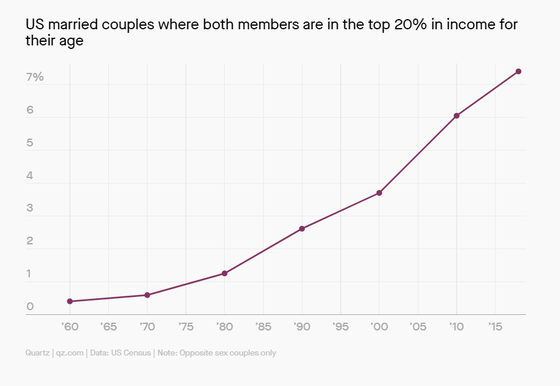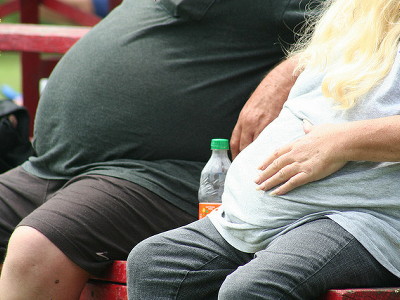Claim that 'high-income people tend to choose high-income partners for marriage partners' is expanding the gap between rich and poor

The disparity society, in which the high-income group and the low-income group differ in many aspects such as economy, health, and education , is becoming more and more problematic, especially in developed countries. Among various reasons for the widening disparity, Quartz of international news media cites one of the reasons as 'the tendency of high-income people to choose the same high-income people as marriage partners'.
High-income people in the US keep marrying each other — Quartz at Work
According to 2018 U.S. Census Bureau data, about 52% of U.S. gross domestic income (GNI) comes from the top 20% of households with more than $ 130,000 in annual income. That there is. Also, the top 5% of households with annual incomes exceeding $ 248,729 (about 25.8 million yen) have a 23% share of GNI, which seems to have increased by about 7 points in 50 years.
This data illustrates the widening gap between rich and poor in the United States. It has been argued that the reasons for the widening gap between rich and poor include `` tax insufficiency, '' `` hollowing out of the middle class, '' and `` rising educational expenses, including university, '' but Quartz states that We can also find the reason for the disparity society in the tendency of marriage. '
Analysis of US Census Bureau data showed that in 1960 only 0.4% of married couples belonged to the top 20% of incomes, reaching 7.4% in 2018.
Below is a graph showing the change in the percentage of both couples in the top 20% of income from 1960 to 2018. According to Quartz, if you get married randomly, regardless of your income, that figure will be around 4%, and people with higher incomes are more likely to marry people with similar incomes. It can be said.

Quartz argues that 'women's social advancement' is a big reason why people with higher incomes are more likely to marry.
In the past, most of the couples were 'high-income men and low-income women' because of the prejudice that men go out to work and women do housework. However, equal employment opportunities are now being advocated by men and women, and it is known that more than 75% of women between the ages of 25 and 54 have employment. With the advancement of women in society, the proportion of high-income women married to high-income men is increasing. In 1960, the top 10% of women married men of the same age and the same age group at 11% However, it has risen to about 25% in 2018.

One of the reasons for the high rate of marriage among high-income earners is that Quartz points out the 'correlation between college education and household income.' A study published in 2014 found that those who graduated from the university in the 2000s were more likely to marry those who graduated from the university.
On the other hand, there is a strong correlation between graduation from college and high incomes, so it can be said that 'well-educated couples with high education levels' are likely to be born. Furthermore, when high incomes are married and their children are born, the children can also receive a high level of education, so the disparity from childhood will be large. Richard Reeves and Joanna Benatar, researchers at the Brookings Institution , said, `` By making men and women with high incomes married and their children becoming high incomes, further disparity society will progress across generations. '' Pointed out.
Related Posts:
in Note, Posted by log1i_yk







